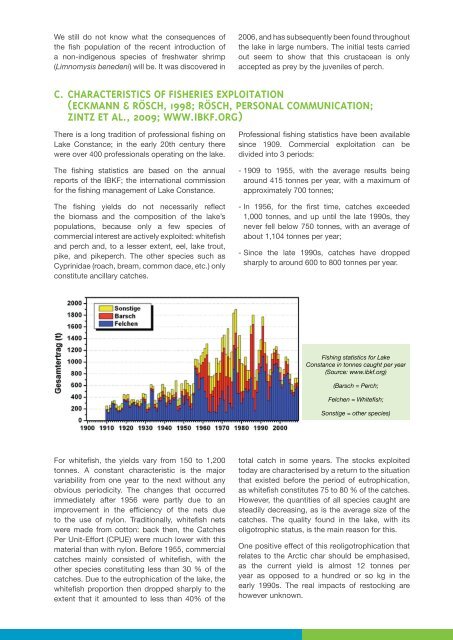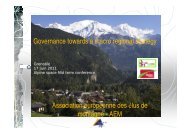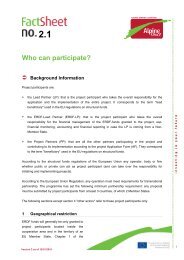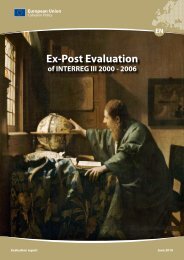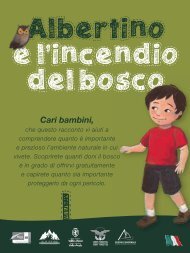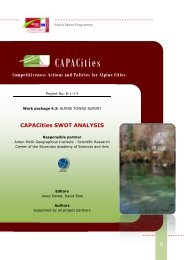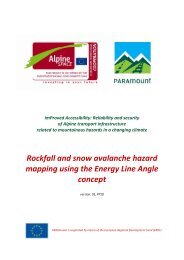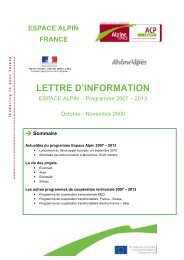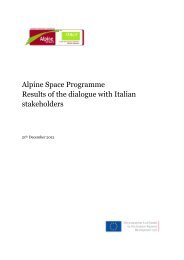Sustainable management of leisure and professional fisheries at the ...
Sustainable management of leisure and professional fisheries at the ...
Sustainable management of leisure and professional fisheries at the ...
You also want an ePaper? Increase the reach of your titles
YUMPU automatically turns print PDFs into web optimized ePapers that Google loves.
We still do not know wh<strong>at</strong> <strong>the</strong> consequences <strong>of</strong><br />
<strong>the</strong> fish popul<strong>at</strong>ion <strong>of</strong> <strong>the</strong> recent introduction <strong>of</strong><br />
a non-indigenous species <strong>of</strong> freshw<strong>at</strong>er shrimp<br />
(Limnomysis benedeni) will be. It was discovered in<br />
2006, <strong>and</strong> has subsequently been found throughout<br />
<strong>the</strong> lake in large numbers. The initial tests carried<br />
out seem to show th<strong>at</strong> this crustacean is only<br />
accepted as prey by <strong>the</strong> juveniles <strong>of</strong> perch.<br />
C. CHARACTERISTICS OF FISHERIES EXPLOITATION<br />
(ECKMANN & RÖSCH, 1998; RÖSCH, PERSONAL COMMUNICATION;<br />
ZINTZ ET AL., 2009; WWW.IBKF.ORG)<br />
There is a long tradition <strong>of</strong> pr<strong>of</strong>essional fishing on<br />
Lake Constance; in <strong>the</strong> early 20th century <strong>the</strong>re<br />
were over 400 pr<strong>of</strong>essionals oper<strong>at</strong>ing on <strong>the</strong> lake.<br />
The fishing st<strong>at</strong>istics are based on <strong>the</strong> annual<br />
reports <strong>of</strong> <strong>the</strong> IBKF; <strong>the</strong> intern<strong>at</strong>ional commission<br />
for <strong>the</strong> fishing <strong>management</strong> <strong>of</strong> Lake Constance.<br />
The fishing yields do not necessarily reflect<br />
<strong>the</strong> biomass <strong>and</strong> <strong>the</strong> composition <strong>of</strong> <strong>the</strong> lake’s<br />
popul<strong>at</strong>ions, because only a few species <strong>of</strong><br />
commercial interest are actively exploited: whitefish<br />
<strong>and</strong> perch <strong>and</strong>, to a lesser extent, eel, lake trout,<br />
pike, <strong>and</strong> pikeperch. The o<strong>the</strong>r species such as<br />
Cyprinidae (roach, bream, common dace, etc.) only<br />
constitute ancillary c<strong>at</strong>ches.<br />
Pr<strong>of</strong>essional fishing st<strong>at</strong>istics have been available<br />
since 1909. Commercial exploit<strong>at</strong>ion can be<br />
divided into 3 periods:<br />
- 1909 to 1955, with <strong>the</strong> average results being<br />
around 415 tonnes per year, with a maximum <strong>of</strong><br />
approxim<strong>at</strong>ely 700 tonnes;<br />
- In 1956, for <strong>the</strong> first time, c<strong>at</strong>ches exceeded<br />
1,000 tonnes, <strong>and</strong> up until <strong>the</strong> l<strong>at</strong>e 1990s, <strong>the</strong>y<br />
never fell below 750 tonnes, with an average <strong>of</strong><br />
about 1,104 tonnes per year;<br />
- Since <strong>the</strong> l<strong>at</strong>e 1990s, c<strong>at</strong>ches have dropped<br />
sharply to around 600 to 800 tonnes per year.<br />
Fishing st<strong>at</strong>istics for Lake<br />
Constance in tonnes caught per year<br />
(Source: www.ibkf.org)<br />
(Barsch = Perch;<br />
Felchen = Whitefish;<br />
Sonstige = o<strong>the</strong>r species)<br />
For whitefish, <strong>the</strong> yields vary from 150 to 1,200<br />
tonnes. A constant characteristic is <strong>the</strong> major<br />
variability from one year to <strong>the</strong> next without any<br />
obvious periodicity. The changes th<strong>at</strong> occurred<br />
immedi<strong>at</strong>ely after 1956 were partly due to an<br />
improvement in <strong>the</strong> efficiency <strong>of</strong> <strong>the</strong> nets due<br />
to <strong>the</strong> use <strong>of</strong> nylon. Traditionally, whitefish nets<br />
were made from cotton: back <strong>the</strong>n, <strong>the</strong> C<strong>at</strong>ches<br />
Per Unit-Effort (CPUE) were much lower with this<br />
m<strong>at</strong>erial than with nylon. Before 1955, commercial<br />
c<strong>at</strong>ches mainly consisted <strong>of</strong> whitefish, with <strong>the</strong><br />
o<strong>the</strong>r species constituting less than 30 % <strong>of</strong> <strong>the</strong><br />
c<strong>at</strong>ches. Due to <strong>the</strong> eutrophic<strong>at</strong>ion <strong>of</strong> <strong>the</strong> lake, <strong>the</strong><br />
whitefish proportion <strong>the</strong>n dropped sharply to <strong>the</strong><br />
extent th<strong>at</strong> it amounted to less than 40% <strong>of</strong> <strong>the</strong><br />
total c<strong>at</strong>ch in some years. The stocks exploited<br />
today are characterised by a return to <strong>the</strong> situ<strong>at</strong>ion<br />
th<strong>at</strong> existed before <strong>the</strong> period <strong>of</strong> eutrophic<strong>at</strong>ion,<br />
as whitefish constitutes 75 to 80 % <strong>of</strong> <strong>the</strong> c<strong>at</strong>ches.<br />
However, <strong>the</strong> quantities <strong>of</strong> all species caught are<br />
steadily decreasing, as is <strong>the</strong> average size <strong>of</strong> <strong>the</strong><br />
c<strong>at</strong>ches. The quality found in <strong>the</strong> lake, with its<br />
oligotrophic st<strong>at</strong>us, is <strong>the</strong> main reason for this.<br />
One positive effect <strong>of</strong> this reoligotrophic<strong>at</strong>ion th<strong>at</strong><br />
rel<strong>at</strong>es to <strong>the</strong> Arctic char should be emphasised,<br />
as <strong>the</strong> current yield is almost 12 tonnes per<br />
year as opposed to a hundred or so kg in <strong>the</strong><br />
early 1990s. The real impacts <strong>of</strong> restocking are<br />
however unknown.


